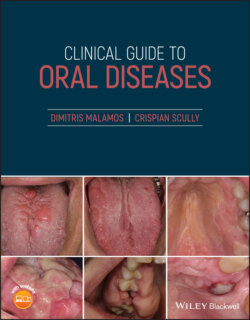Читать книгу Clinical Guide to Oral Diseases - Crispian Scully - Страница 39
Case 3.3
ОглавлениеFigure 3.3
CO: A 42‐year‐old Caucasian men presented with dark brown discoloration of his gingivae.
HPC: The gingival discoloration had been observed in the patient over the last 10 years, but became more intense within the last 2 years when the patient started smoking cigars.
PMH: This patient suffered from a mild hypertension and hyper‐cholesterolemia, both being controlled with the help of a special diet. He was allergic to pollen and suffers from hayfever; when severe, anti‐histamines are used. He is a workaholic and started smoking cigarettes from the age of 14. However, over the last two years the patient switched to cigars (>15/day).
OE: Physical examination revealed a tall, thin, dark complexioned man with no serious skin problems apart from a yellow stain on his right hand and especially on the nails of the middle and index fingers. His intra‐oral examination showed multiple brown patchy discolorations of the upper and lower gingivae extended to the inter‐dental papillae and the attached gingivae and buccal sulcus (Figure 3.3).This discoloration was darker in the anterior lower gingivae than in the buccal mucosae and dorsum of the tongue and lower lip, where the patient lights up his cigar.
Q1 What is/or are the possible cause(s) of gingival pigmentation?
1 Metal poisoning
2 Smoker's melanosis
3 Drug‐induced melanosis
4 Gingival melanoma
5 Racial pigmentation
Answers:
1 No
2 Smoker’s melanosis is confirmed by the dark gingival pigmentation especially on his anterior lower gingivae with a benign course and reinforced by yellow staining from nicotine on the middle and index finger nails, where his cigars were hold.
3 No
4 No
5 Having in mind the patient’s race (Caucasian) and his dark complexion, the gingival pigmentation could be attributed to racial pigmentation in addition to smoker's melanosis.
Comments: The characteristics of the patient's gingival pigmentation regarding the color (brown rather than blue or black), distribution (all gingivae and not ion‐free or mesio‐dental gingivae), type (band and not zone) in combination with the lack of recent exposure to toxic chemicals, exclude metal poisoning from the diagnosis. The homogeneity and not the gradation of brown discoloration, along with its morphology (plaque and not growth) or its progress (slow and not rapid) and lack of symptomatology and lympho‐adenopathy rule out oral melanoma from the diagnosis.
Q2 Which of the oral lesions below is/or are not related to smoking?
1 Leukoplakia
2 Nicotinic stomatitis
3 Hairy leukoplakia
4 Acute ulcerative gingivitis
5 Oral squamous cells carcinoma
Answers:
1 No
2 No
3 Hairy leukoplakia in contrast to hairy tongue lesion is not related to smoking. Hairy leukoplakia appears as a white corrugated lesion on the lateral margins of the tongue and is strongly related to Epstein‐Barr virus (EBV) infection in immunocompromised patients, which is partially responding to anti‐viral therapy.
4 No
5 No
Comments: Smoking can be involved in the pathogenesis of various oral lesions in several ways. The heat produced with smoking causes mouth dehydration, leading to difficulties in removal of dead epithelial cells (washing), retardation of the normal rate of desquamation on the dorsal surface of tongue, producing a hair‐like appearance which is susceptible to colonization of chromogenic bacteria as seen in a hairy‐coated tongue. The carcinogenic chemicals that are released with smoking damage the DNA, and delay the healing process, causing the accumulation of abnormal cells, with cancer development. Smoking provokes xerostomia, together with nicotine which induces gingival vasoconstriction. This as well as the impaired host immunity, enhances the pathogenic action of various bacteria in gingival diseases, especially in acute ulcerative gingivitis/stomatitis. The nicotine causes vasoconstriction of the palatal blood vessels and at the same time, the irritation of the mucosa from heat and various toxic irritants cause hypertrophy of the mucosa and inflammation of the ducts of minor salivary glands, as has been observed in nicotinic stomatitis.
Q3 Which of the tobacco chemicals below is/or are NOT related to cancer development?
1 Nicotine
2 Polycyclic aromatic hydrocarbons (PAHs)
3 Essence oils
4 Herbs
5 Nitrosamines
Answers:
1 No
2 No
3 Essence oils embedded on rolling papers or blends have been used in some tobacco products in small quantities, having a minimum risk of cancer development.
4 Various products from thyme, rosemary, and chamomile, intermingled with tobacco blends and essence oils increase the flavor and make cigars more attractive.
5 No
Comments: The most important carcinogens in tobacco products are nicotine, nitrosamines, and PAHs which affect cell growth and apoptosis, expression of oncogenes, neovascularization, and treatment response.
